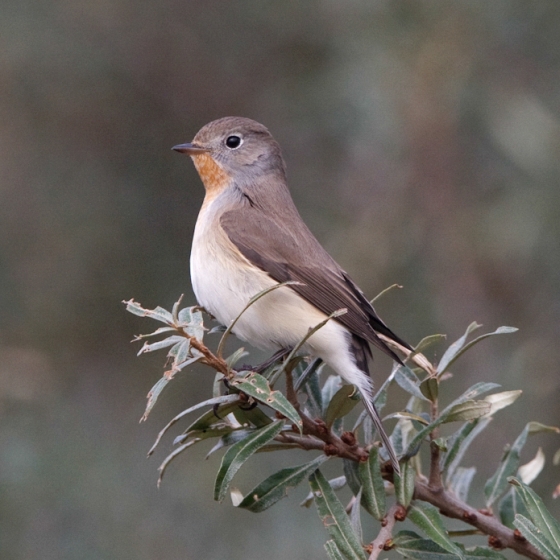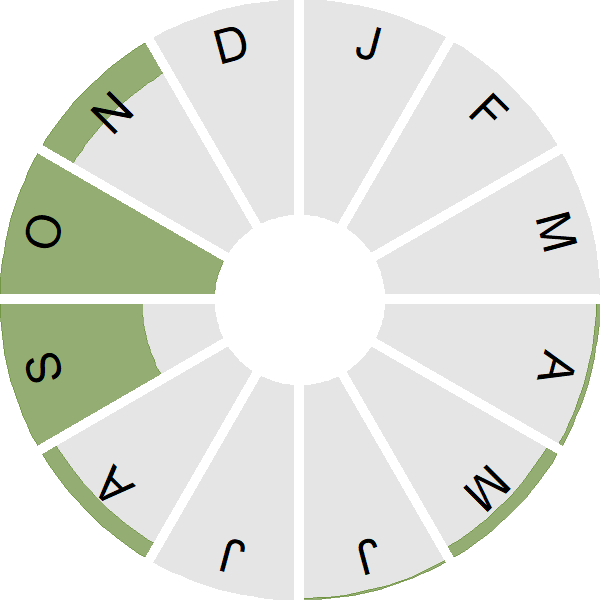Red-breasted Flycatcher

Introduction
The Red-breasted Flycatcher resembles a pale Robin, with its black and white patterned tail characteristically cocked. This is a scarce migrant from central and eastern Europe, that is commoner in autumn than spring. Annual numbers are thought to be around 100 individuals.
Breeding from central Europe east to the Ural Mountains, Red-breasted Flycatcher is a migrant, whose wintering grounds are in India.

Key Stats
Identification
Songs and Calls
Song:
Status and Trends
Conservation Status
Population Size
Population Change
Red-breasted Flycatcher is a scarce passage migrant to the UK, seen during both spring and autumn migrations [Parkin & Knox 2010]. The number of individuals reported in the UK each year is rather variable, but there is no apparent long-term trend [White & Kehoe 2024]. At the European scale, the population is thought to be increasing [BirdLife International 2021].
Distribution
This species is a rare vagrant and was recorded during Bird Atlas 2007–11 as shown on the map.
Occupied 10-km squares in UK
or view it on Bird Atlas Mapstore.
or view it on Bird Atlas Mapstore.
European Distribution Map
Distribution Change
This vagrant is too rarely reported to map distribution change.
Change in occupied 10-km squares in the UK
Seasonality
Red-breasted Flycatcher is a scarce autumn passage migrant, typically encountered in September and October; there are occasional spring records.
Weekly pattern of occurrence
The graph shows when the species is present in the UK, with taller bars indicating a higher likelihood of encountering the species in appropriate regions and habitats.

Movement
Britain & Ireland movement
Foreign locations of birds ringed or recovered in Britain & Ireland
Dots show the foreign destinations of birds ringed in Britain & Ireland, and the origins of birds ringed overseas that were subsequently recaptured, resighted or found dead in Britain & Ireland. Dot colours indicate the time of year that the species was present at the location.
- Winter (Nov-Feb)
- Spring (Mar-Apr)
- Summer (May-Jul)
- Autumn (Aug-Oct)

Biology
Productivity and Nesting
Nesting timing
Egg measurements
Clutch Size
Survival and Longevity
Survival is shown as the proportion of birds surviving from one year to the next and is derived from bird ringing data. It can also be used to estimate how long birds typically live.
View number ringed each year in the Online Ringing Report.
Biometrics
Wing length and body weights are from live birds (source).
Wing length
Body weight
Ring Size
Classification, names and codes
Classification and Codes
- Order: Passeriformes
- Family: Muscicapidae
- Scientific name: Ficedula parva
- Authority: Bechstein, 1792
- BTO 2-letter code: FY
- BTO 5-letter code: REBFL
- Euring code number: 13430
Alternate species names
- Catalan: papamosques menut
- Czech: lejsek malý
- Danish: Lille Fluesnapper
- Dutch: Kleine Vliegenvanger
- Estonian: väike-kärbsenäpp
- Finnish: pikkusieppo
- French: Gobemouche nain
- German: Zwergschnäpper
- Hungarian: kis légykapó
- Icelandic: Peðgrípur
- Irish: Cuilire Broinnrua
- Italian: Pigliamosche pettirosso
- Latvian: mazais muškerajs
- Lithuanian: mažoji margoji musinuke
- Norwegian: Dvergfluesnapper
- Polish: mucholówka mala
- Portuguese: papa-moscas-real
- Slovak: muchárik malý
- Slovenian: mali muhar
- Spanish: Papamoscas papirrojo
- Swedish: mindre flugsnappare
- Welsh: Gwybedog Brongoch

